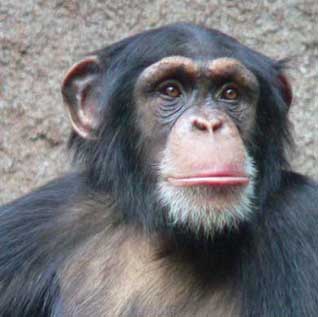

As noted in the previous lesson, humans are classified as Primates because we have the traits used to define the Primate Order, and because we have these traits (and the DNA that determines them) because all Primates evolved from common ancestors. According to the fossil evidence, those ancestors lived some 60 million years ago.
We also belong to the Suborder Anthropoidea, which includes monkeys and apes as well as humans, all for the same two reasons. Of the Anthropoids, a comparison of physical traits (as well as evidence from biochemistry and DNA) indicate that we are more like the monkeys and apes of Africa and Asia than we are like the monkeys of the Americas. Indeed, it is our obvious similarities to the apes, particularly the apes of Africa (gorillas, chimpanzees, and bonobos) that led most scientists in the late 19th century to conclude that our common ancestors should be in Africa, and that Africa was likely where the earliest humans evolved. This is now well established by many different types of evidence.
Direct comparison of DNA between humans, chimpanzees, and bonobos establishes that we are the closest living relative of both chimps and bonobos. We share as much as 98.8% of our DNA with both species. We (and chimps and bonobos) share a bit less with living gorillas.


A Male Chimpanzee (left) and Female Bonobo with Infant (Right)
We did not evolve from chimps or any modern species of ape; modern humans, chimps and bonobos have common ancestors that lived some 6 million years ago (mya) or more. The details of the evolution of our common ancestors is beyond the scope of this course, but clearly the Miocene of Africa (some 23 mya) contained many more species of hominoids and hominids (using the classification in the previous lesson) than now exist on earth. Hominoids generally are capable of brachiation--arm over arm locomotion, which is made possible by the fact that we all have identical shoulder structure, and a shoulder blade on the back of the ribcage (rather than on the side as in more quadrupedal monkeys. All the African apes, as well as humans, are capable of brachiation, and all of the African apes use this form of locomotion from time to time. Gorillas, as well as chimps and bonobos, are more likely to use a form of locomotion referred to as knuckle walking. Humans--the hominins--are specialized in many parts of our skeleton (feet, spinal column, pelvis) to bipedal locomotion, that is, walking upright on two feet. This specialization began to develop some 5-6 mya, as the wet Miocene turned into the dryer Pliocene. For this class, the story begins with the oldest species to definitely show some of the traits of this specialization, the fossil Ardipithecus ramidus.